This is my third year going to the start of the Watertribe Everglades Challenge, and I decided this time around to see more than just the start of the race. The past two years, I have witnessed the start from the beach at Fort Desoto Park in Tampa Bay, then followed the race on the internet. This year I decided to go to a couple of the checkpoints to see the racers on the water. Plans changed along the way and I only got to see them at Checkpoint 1, which was Cape Haze Marina this year. These Watertribe people have infected my mind with whatever lunacy it is that makes them want to travel almost 300 miles down the Florida coast in small boats, and the Everglades Challenge remains on my bucket list.
I got to Fort Desoto just after 6 am and went to drop off some bananas from my yard that I had promised to Watertribers DonKeyHoTee and MicroTom. I missed them, but did get a neat picture of their modified Lightning sailboat, Hare on Fire. The flash from my camera lit up the name graphics, adding a little life to the shot. Unfortunately, I cut the banana stalk too late and they sailed very fast, so I doubt they got to enjoy them during the race.

With the sun and departure time coming up fast, my next step was to take a walk along the beach with my video camera. There was a truly amazing variety of boats in the field of 100+ adventure racers this year. This is why I am so fascinated by this race. So many solutions to the problem of how to race a small boat in these waters, and so many different ways to fail in the attempt. Many drop out every year, which is one reason it's called a challenge. This is my kind of boating and takes place in my back yard, but I am far from certain I will finish the race when I try it.
Enjoy this walk along the beach! Most of the boats are deserted because they were conducting the pre-race roll call as I walked.

With strong tailwinds every day, it was a great year for the Core Sound cat-ketches. I believe this one came in second in the race, beating many fast boats. This is a nicely finished new Core Sound 17, but I have forgotten the Watertribe names of the competitors who sailed her. The tribe names people give themselves are funny, but I have a hard time remembering them and a harder time associating them with their real names and boats. I hope some helpful Watertribers will let me know who goes with which boat so I can update this page with the right info and maybe links to the racers' blogs. While all may not finish the race, no one escapes without a great tale to tell.
One problem with fast multihull sailboats is that when the amas (hulls on the sides) submerge in a strong wind, the akas (beams that hold amas) tend to smack into the waves and anyone or anything on the trampolines gets doused with water. I guess the designer of this boat got tired of that effect and so went with skyscraper tramps!

This sailing rowboat, or maybe it's a rowing sailboat, was the best looking boat in the group to me this year. I go mostly to see the strange boats, but also to see works of nautical art, and there were some fine looking boats in the mix this year, but this one was the best. I complimented the crew on it as they left checkpoint one the next day and one of them said that the other one had built it. Again I can't recall the tribal names that go with the boat.
Next to it was this odd-looking craft named Bob that looked at bit like a shipwreck, with gear strewn about the cockpit and a rig I just could not figure out, plus a strangely attached ama of dubious practical value. This is exactly the kind of thing I come to see! My favorite boat of the year! More on this one, and some pictures of that weird rig in use, in the next section of my report.

This little yellow sailboat named Sundance seems to me a fine boat for the Everglades Challenge. It can be rowed or sailed, and while it probably can't do either all that fast, it has some protection from the elements and fast tends to translate to wet in boats. With overnight lows in the 30s and 40s for this year's event, staying dry seemed like a very good idea.
Speaking of staying dry, many of the participants bring and wear drysuits, among other required safety gear for the event, and the sailor on that Prindle 19 beach cat in the background had the misfortune of using his safety gear for its intended purpose. He hit something in the Gulf off Venice, holed a hull, and the boat capsized and sank! He was wearing a drysuit and had a PLB and waterproof VHF radio, so the Coast Guard was able to find and rescue him quickly, but the boat was lost. I guess this is one of the last pictures of it.
While it would be nice to take a boat like Sundance, and fast to take a beach cat, assuming it stayed in one piece, I just do not understand the people who choose boats like this little blue pram for this race. Maybe he was only competing in the Ultra Marathon, but to me, even Cape Haze seems like a pretty long way to go in such a little boat. I like small boats, but not that small for anything but a daysail.

The sailors competing on this sleek, red trimaran had a great idea with those seats. Comfort is important but hard to achieve if you're going to be in a small boat for a long time, and those look comfortable. This boat has another solution to the "wet stuff on the trampolines" problem mentioned above: keep everything in close to the vaka (center hull). The problem with that approach is that I don't see any way that the forward passenger could paddle the boat if needed. It was not a problem this year since they had favorable winds.
Speaking of boats that are hard to paddle, the Sailbird trimaran Big Red looks like quite a load to push off the beach or to paddle, but must be a nice boat to sail. The little blue Puffer next to it strikes me as a bit small for this race, but that means it should be relatively easy to launch and row. I liked the bow canvas and offset bowsprit. I guess it flies an asymmetric spinnaker from the bowsprit.

These two look like multihull sailboats to me, but ones with very different character. In the background is a 16' Hobie Getaway, a rotomolded plastic production boat designed for family fun. It competed last year with Watertribers Coastie and Clam Counter, but they did not finish the race due to a rigging failure. They made it to Key Largo this year.
The one in the foreground is actually not a multihull sailboat at all, at least according to Watertribe classification rules. It's an expedition canoe with inflatable amas and a Hobie Mirage Drive, and because the amas and akas can be taken apart and put in the boat, it competes in the class with sailing kayaks and canoes, not multihull sailboats. That one was built by the Watertribe's Chief and modified by a guy who goes by "kayakman7" on the Hobie Adventure Island forums.
Next to the expedition canoe was a Windrider 17 trimaran, a boat that strikes me as an odd choice for the Everglades Challenge. It draws enough water to be limited by some of the shallows along the routes and the rudder does not retract. They are available with a bowsprit and screecher sail, but this one was not equipped with those, making it a bit underpowered and slow compared to some of the other multihull sailboats. It also looks like a boat that would be hard to paddle effectively. I would call the decision to use this boat in the Everglades Challenge ambitious to say the least.
In the foreground of the picture at left is a Welsford Walkabout built by Watertriber "Chuck the Duck," who runs Duckworks Magazine. While I enjoy seeing the efforts of the various amateur designers and builders in this race, I wish more professional boat designers would turn their attention to events like this one. John Welsford is one who did, and my favorite design of his, the SCAMP, did well in last year's race, right up until they got stuck on one of the infamous Florida Bay mud flats for several days when an unfavorable wind blew all the water out of the Bay. Anyway, because I admire Welsford's designs and Chuck the Duck's magazine, I was interested in how this boat would fare in the race. Crewing with Chuck was Watertriber "Lugnut" whose boat Oaracle was among my favorite the past couple of years. I was disappointed to learn that Oaracle would not be in the race because I thought it was among the most interesting boats. I don't think I would have chosen lavender and orange as a color scheme, but despite the paint job the Walkabout is a better looking boat than Oaracle. I still think I would enjoy racing aboard Oaracle more than on the Walkabout.

Next to the Welsford Walkabout was Dawn Patrol, a Core Sound 20 modified with a bowsprit and cuddy cabin. With the modifications, it is similar to one of my favorite boats, the Everglades Challenge 22 from the same designer, Graham Byrnes of B and B Yacht Designs. He held the monohull course record in the Everglades Challenge using his 22 footer until this year, when favorable winds allowed Watertribers DancesWithSandyBottom and SOS in Dawn Patrol to beat it by several hours.
In the foreground is a small lug-rigged sailboat sort of similar to the Welsford Walkabout above, but with only one mast. I read somewhere, probably on Facebook, what this boat is and who sails it, but can't remember. Whatever it is, it is both beautiful and practical, if a bit exposed for my taste. Did I mention the weather was really cold this year? Nowhere to hide on that little beauty.
Next on the beach were a pair of Sea Pearl 21 monohulls. One was perennial participant Jarhead sailing solo in his boat Moon Shadow and I have forgotten who was on the other one. There was also a Sea Pearl trimaran in the race this year, and all finished with respectable times. I once worked at a boat show next to Mike from Marine Concepts, makers of the Sea Pearl, and talked to him at length about the boats during lulls in customer traffic. Nice guy who makes really neat boats!

Running a close second behind Bob on my favorite boats list this year was this trimaran called Finger Mullet, sailed by Watertriber DancesWithMullet. He competed in the 2011 Everglades Challenge in a small Blue Jay sailboat named Mullet and must have decided these multihull sailors were onto something. He launched Mullet by spinning her down the beach, a technique that did not look particularly graceful, but did work. He gets extra points this year for the creative use of a blue polytarp "runway" lashed to the bow to be self-deploying as the boat skids down the beach. It seemed to work well.
Finger Mullet sports another solution to the aka and trampoline submersion problem with her built up ama pods to hold the akas and trampolines higher above the water. The hard dodger built around the cockpit looks like it would provide nice protection from rain coming from any direction other than astern. I'm not sure what to make of the hull shape. It looks like a sharpie hull riding on a torpedo or something. A truly weird little boat, and I love it!
This shot from astern shows the name apparently applied to the transom with a Sharpie marker or something. I read on the Watertribe forum that DancesWithMullet barely finished building the boat in time for the race and had no time to finish fairing and painting it. It was water-ready, so he raced it! I like that approach. If people don't like the way it looks, they can look in another direction.

Moving on down the beach, I found a group of four Hobie Adventure Islands. Since my wife and I are Adventure Island owners, I have a soft spot for these boats. They are great fun and have proven themselves capable performers in events like this one over the past few years. This is the cockpit of one belonging to Watertriber Dogslife, who has customized it with foam padding to increase freeboard and floatation and to make it more comfortable for sleeping aboard. Yes, sleeping in that cockpit! Dogslife is a relentless competitor and talented blogger and photographer/videographer who always shares great tales of his adventures on his blog and the Hobie Adventure Island forums, among other places. He put in an impressive performance this year, finishing far ahead of the other AI's in the race, and apparently was sick and vomiting for at least part of the race. The determination to keep on moving is pretty darn strong in DogsLife!
Here is a shot of four Adventure Islands lined up on the beach. I saw at least four others scattered around, so I think 8 or 9 were in the race overall, but one might have been doing only the first leg, the Ultra Marathon. I really should be able to tell them apart after reading the EC 2013 thread on the Adventure Island forum, but still can not. The one on the end gives itself away with Chief printed on it in big letters. The Watertribe's Chief has competed in this and other challenge events in a wide range of craft, so it's high praise indeed that he thinks the Adventure Island is a worthy boat for the competition. Hobie designed it to be a fun toy, but it can do some seriously difficult traveling if you can! One of those, I believe sailed by CaptnChaos, has a small roller-furled jib and one of the boats in the race, sailed by Watertriber Penguinman, who is a Hobie design engineer, has a red spinnaker. I would like to get a closer look at how they manage the interaction between headsails and the roller-furling mast. I put a small jib on my AI but have found that it is not worth the trouble. I just wait for a day that is windy enough that I don't need it!

Beside the Adventure Islands on the beach were several sailing kayaks and expedition canoes in a tight cluster. Among those, at least a few belong to female Watertribers: DolphinGal, SandyBottom, and KiwiBird. An event like this one typically attracts men, and most participants in the Everglades Challenge are men, but that does not mean there are no women with the stamina and sense of adventure to enjoy it and do well. I read somewhere that SandyBottom holds an Everglades Challenge course record, and she and her son, Watertriber SOS, did last year's Ultimate Florida Challenge, a circumnavigation of the state that includes a 40 mile portage in north Florida.
Past the group of kayaks and canoes was Watertriber Jolly Roger in another expedition canoe that looks an awful lot like a multihull sailboat to me. Watertribe rules say it is not, though, and he set a new record in the sailing canoes and kayaks class this year. I'm a subscriber to Roger's YouTube channel and really enjoy his soft-spoken narration of his various boat and aircraft building projects and adventures. You can not really see it in my picture, but his pilot seat is a bean bag chair. That's creative innovation!
He sailed another interesting design of his own last year, a ketch rigged trimaran using masts from a Hobie Tandem Adventure Island and a regular Adventure Island, but was smacked in the face by one of his oars, injuring an eye and forcing him to drop out. I was glad to see him do so well this year.

Racing in the "fine furniture" class in more ways than one was Meade Gougeon of West Systems Epoxy with his absolutely gorgeous WoodWind kayak and the best sheepskin-lined seat on the beach. I don't think I could bring myself to expose such a pretty boat to salt and sand. He raced this boat last year, but with no amas and a much smaller sail. This year, he made it down the coast a ways but got tired and beached the boat for some rest, then broke an ama trying to relaunch through the surf and withdrew from the race.
Next to Gougeon's WoodWind were a couple of sea kayaks and then this pair of Triaks. The Triak is a high performance competitor to the Adventure Islands, with a sleeker hull shape, larger daggerboard, smaller amas and an optional asymmetric spinnaker in a snuffer sock mounted on the bow. It also has less carrying capacity than an Adventure Island and no Mirage Drive. I have seen only a few competitors attempt the Everglades Challenge in Triaks and the small carrying capacity is the only reason I can think of. They otherwise seem like a good choice, especially in a downwind sleigh ride like they had this year.

Several Watertribers seem to want to adopt and improve upon the Adventure Island trimaran technology. This one is a tandem sea kayak with a Hobie mast and sail and amas that look similar to the ones on a tandem Adventure Island, but with akas that slide in from the sides instead of inserting into sockets on top. The reaction over on the Hobie Island forums has been that imitation is the sincerest form of flattery.
Also in the picture are parts of four more Adventure Islands, one mast barely visible behind the angled Triak mast, two behind the Triaks, and one ama on the right side of the picture.
Among all the different kayaks and canoes I saw this Nomad sailboat, one of the couples teams being sailed by Watertribers ZerotheHero and GreenMountainGal. As her name implies, I think they came all the way from Vermont to do this race! The Nomad is an open boat, but ZerotheHero reported that its size and high freeboard kept them pretty dry most of the time.

An internet discussion of the trimaran Sizzor created by Watertriber Sew Sew (aka sailmaker Randy Smyth) was one of the first things that drew my attention to the Everglades Challenge. This high tech trimaran has amas that swing in close to the hull, one swinging forward and one aft, kind of like a pair of scissors. In previous years, the ability to reduce the beam of the boat and lower the mast on the water was necessary in order to clear a low and narrow fixed bridge and reach the first checkpoint. This year, that checkpoint was moved to Cape Haze marina, just off the intracoastal waterway, so that capability was not needed. I still find Sew Sew's solution to the problem ingenious, even if the problem went away.
Sizzor had a new suit of green sails and some new flat-bottomed amas and Sew Sew stood a good chance of breaking the all time course record this year, but unfortunately capsized in the Gulf between Fort Myers and Naples and had to withdraw from the race.
When I bought my Klepper Aerius Expedition folding kayak over 15 years ago, I had been looking around on the internet at various approaches people had taken to putting sails on kayaks. There were some cobbled-together homemade rigs of various kinds and people were using small windsurfer rigs with homemade amas, but I saw nothing that looked appealing and that was one reason I bought the Klepper with a factory sail kit. I could sail it right away with a proven rig and not have to invent anything. The technology of sailing canoes and kayaks has advanced quite a bit since those days. The picture at left shows a couple of kayaks with relatively short rigs using battens to create a long, square top. Keeping the rig low means no amas are required to keep the boat upright when sailing, but the square top sails still have a fairly large area. In the background is another sail that does not extend all the way to the top of its mast. That one has zippered panels that can be removed to reef the sail in strong winds, and some have been removed based on the weather forecasts. Conventional sails always have a bunch of cloth tied up at the foot of the sail when reefed, but removing sections is a far neater solution.
At the right in that picture is an old Hobie 16 being sailed by Watertribers Crazy Lugan and Heathen. Great to see the classic beach cat in the race, even if you do have to be a bit crazy to try the Everglades Challenge in one. They did well in the race, particularly the first leg to checkpoint one. I took pictures of them there when they arrived shortly after Sew Sew in Sizzor and before anyone else. They were happy to hear that they were in second place at the time.

At the right side of this picture is the rest of the Hobie 16 (sorry for cutting your boat in half, Crazy Lugan and Heathen), but the main subject is Watertriber StandUpGuy, aka Shane Perrin, with his custom 18 foot stand up paddleboard. I had seen a couple of people attempt the Everglades Challenge on SUP's before and thought they failed their sanity test. They did not finish. I took this picture mainly to show what a crazy person looks like before he fails to complete the race. I figured he might make it to Sarasota at best. How wrong I was.
StandUpGuy Shane is a kidney transplant recipient and is racing to promote and raise funds for his charity to bring the joy of paddleboarding to organ donation recipients and dialysis patients. He is also a very capable paddleboarder. He made it to Marco Island, where some thieves stole all of his electronics as he slept. The theft from a charity fundraiser attracted a lot of attention on the internet, including mine, and not wanting to see the bad guys win, I made a small donation to his charity, as did many other people in various internet boating communities. I later learned from Facebook updates by his wife that Shane had been disheartened by the theft and planned to pull out of the race, but his faith and strength were restored when he saw all the support he was getting and he continued on to Key Largo. He then continued on and paddled down to Key West! OK, so I was a few hundred miles off in my misunderestimation of him!
This Hobie Adventure Island has been modified to eliminate a couple of my complaints about the design. Even when empty, if I leave the scupper plugs under the seat open in my Adventure Island, I wind up sitting in a small puddle of water. Also, the bow tends to drive right through waves and when the wave hits the aka, I get very wet. This one has a padded seat placed high on some kind of support and spray shield skirts on each side, which should make it a much drier ride. I doubt it is possible to stay dry in an Adventure Island when going fast through waves of any size, but at least this one can stay a lot drier than mine!
The trampolines probably help some with the problem of waves sloshing over the sides in a beam sea, but I think that if I ever modify mine to carry cargo and/or people out there it will be using hakas. They will hold things up higher without sagging, allow paddling, and I have seen people use small surfboards as hakas, providing fun dinghies, and hakas as picnic tables and sleeping platforms.

Next to the modified Hobie Island was this small herd of sea kayaks. I like paddling and have a sit-on-top along with the Klepper foldable mentioned above, but really can't see the appeal of paddling all the way to Key Largo without at least some assistance from a sail. My hat is off to those who do it though!
At the other end of the spectrum, I also would not want to try the EC on a pure sailboat that has very limited ability to move under human power when needed. I have paddled a beach cat once out of necessity and it was not fun. I believe this Mystere 4.3 was the smallest of the beach cats in the race, but wow, what a bowsprit on that thing! Beach cats have a spotty history in the Everglades Challenge, being prone to capsize and break or just wear out their crews, but this one finished along with most of the others this year and made pretty good time.

A few more boats from the "you must be kidding" files on the beach before the start. First, a Nutshell pram named Rocking Baby, another fine looking furniture-grade wooden boat that seems to me a bit small for long range cruising. It also seems too nice to expose to sand and salt.
Also two Coreban SUP's and a modified Hobie 18 sailed by Watertriber JustAnotherSailor, who was the third one to arrive at checkpoint one later in the day. JustAnotherSailor apparently had quite an adventure in the Gulf outside the 10,000 islands and arrived at the Chokoloskee checkpoint 2 pretty well exhausted, but successfully completed the Everglades Challenge this year.
I did not hear how the Coreban stand up paddleboards did, but despite StandUpGuy's astonishing performance I still think that standing up and paddling hundreds of miles does not sound all that possible, let alone fun.

This kayak is rigged as a ketch with a pair of Batwing sails and inflatable amas spread far apart on a single aka beam, which also serves as a leeboard pivot. This is the kind of boat that gives me ideas about re-rigging my Klepper kayak with some modern gear. That is a lot of sail for a kayak! It must be fast!
I took this picture of some of the tandem kayaks mainly because a couple of the Watertribe names are funny to me. The Necky tandem in the foreground has crew labels by each cockpit: Gatorbait and BaitsMate. In the background are a couple of Seaward tandems and another sharp looking solo kayak.

The sun was rising behind a cloud bank as I took this picture looking toward the Sunshine Skyway bridge just before the start of the race.
In the next entry, pictures of the racers departing Fort Desoto beach and some of the arrivals and departures at checkpoint one, Cape Haze Marina.
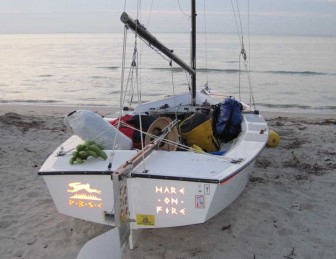
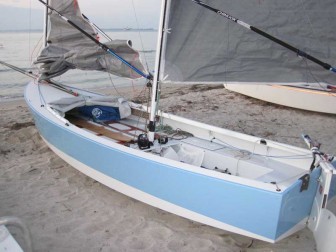
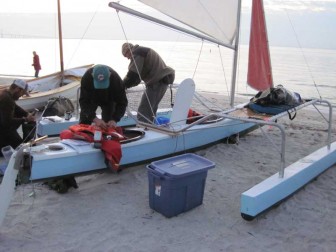
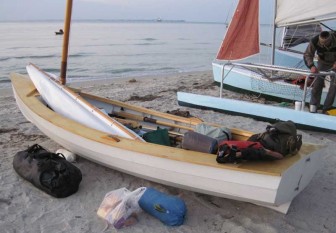
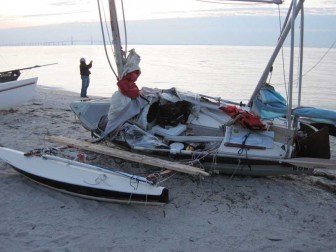
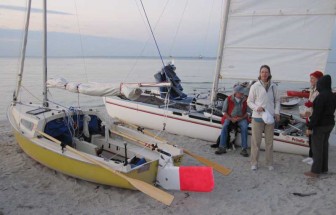
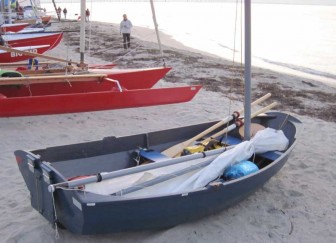
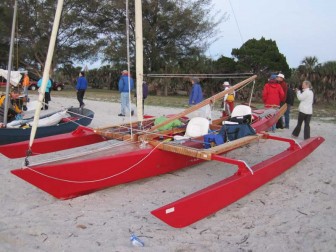
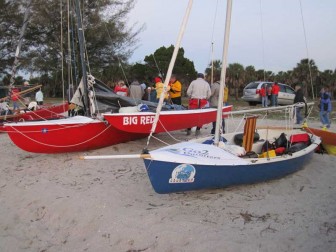
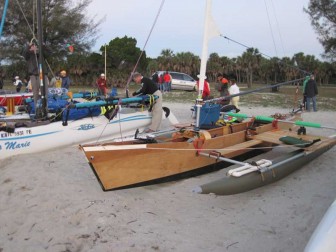
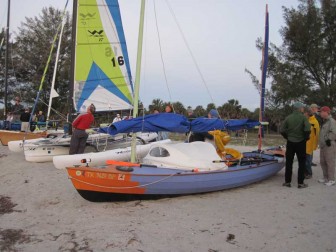
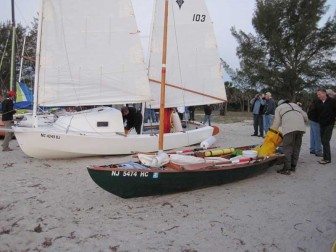
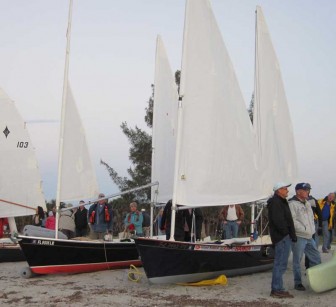
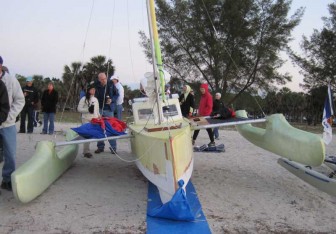
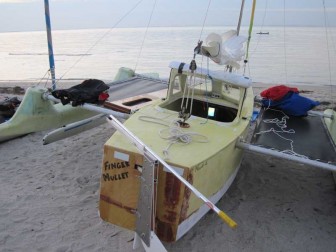
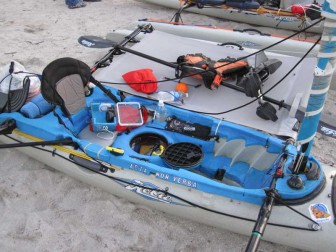
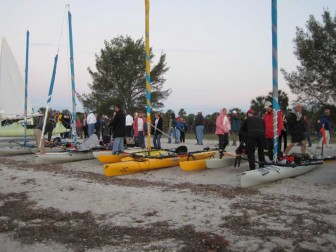
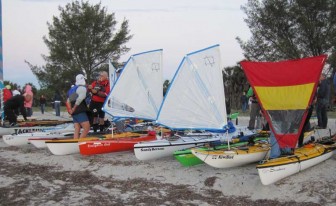
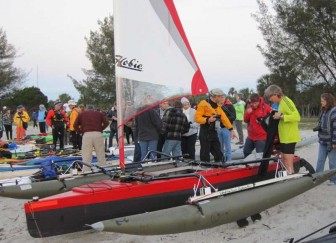
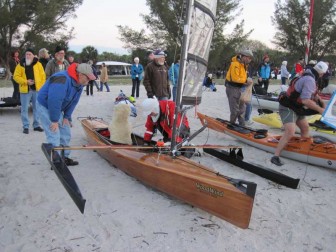
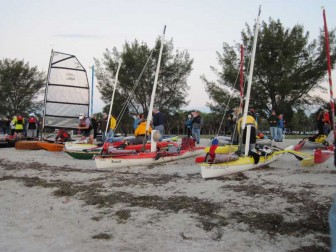
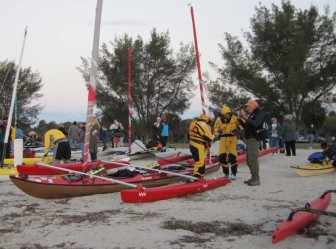
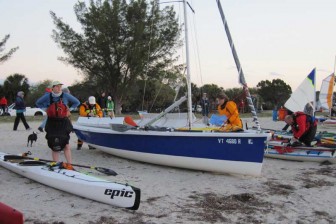
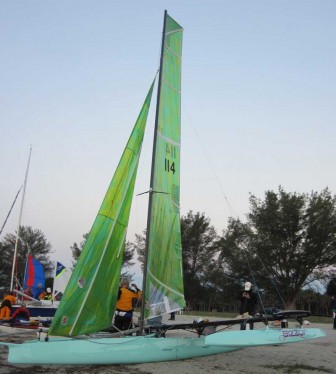
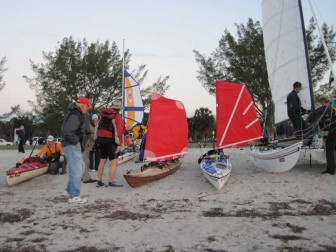
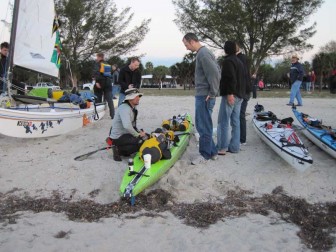
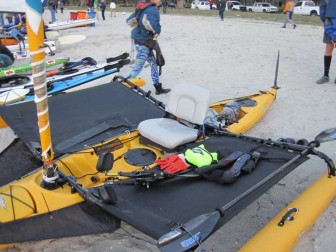
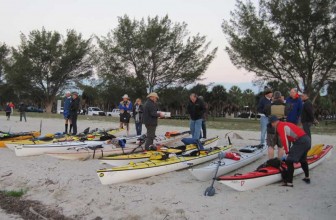
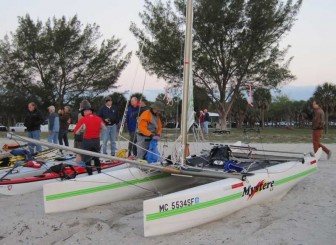
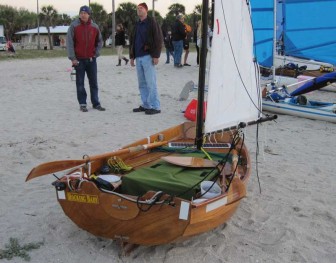
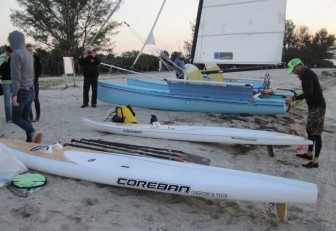
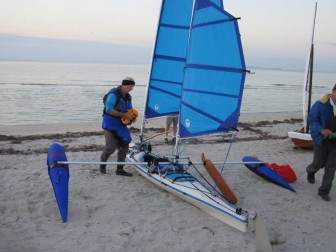
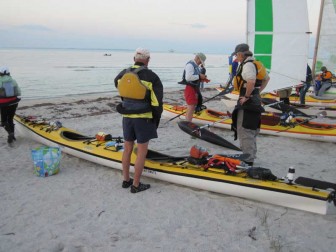
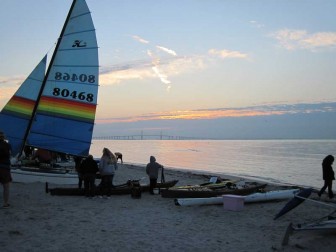
Tom: I should tell you that Sandra picked the colors for my Walkabout and did most of the painting. But she was not surprised that you did not care for her color choices. It’s all good and we will post a link to your blog in Duckworks. We are just happy for the link to Duckworks and the picture. Thanks.
Sorry for my late approval of and reply to your post, Chuck. My site stopped notifying me of comments for some reason and I just stumbled upon the problem today. Tell Sandra that I approve of anyone who backs up her color choices by picking up the paint brush! Congrats on your EC performance and best of luck with the Walkabout!
Hey Tom,
Great gallery of the variety of boats there. I had to have a look after listening to Noel talk about it so often on furled sails. Was he there?
david
David, I was focused on getting some pictures and video and really did not meet or talk to many people at all. I don’t know if Noel was there.